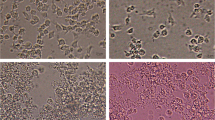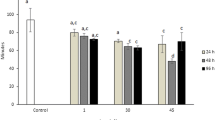Abstract
Methylmercury (MeHg) is highly immunotoxic and can alter the health status of the harbour seal, Phoca vitulina, from the North Sea. To investigate the mechanism of MeHg-induced toxicity in harbour seal lymphocytes, Concanavalin A (ConA)-stimulated peripheral blood leucocytes were exposed in vitro to sublethal concentrations of MeHgCl (0.2, 1, and 2 µM) for 72 h and then analysed for their viability and ultrastructure. After 72 h of incubation, cells were counted with a propidium iodide staining technique, a metabolic MTS assay was performed, and cells exposed to 1 µM of MeHgCl were observed by transmission electron microscopy (TEM). Alive cell numbers decreased with increased MeHgCl concentrations. In presence of ConA and 1 µM of MeHgCl, TEM images revealed a higher frequency of apoptotic cells. Exposed cells displayed condensation of the chromatin at the nuclear membrane and mitochondrial damages. The results suggest that in vitro MeHgCl-induced apoptosis in harbour seal lymphocytes through a mitochondrial pathway.



Similar content being viewed by others
References
Ackerman GA (1970) Structural studies of the lymphocyte and lymphocyte development. In: Gordon A (ed) Regulation of hematopoiesis. Appleton-Century-Crofts, New York, pp 1297–1337
Belkin IM (2009) Rapid warming of large marine ecosystems. Prog Oceanogr 81:207–213. doi:10.1016/j.pocean.2009.04.011
Betti C, Nigro M (1996) The comet assay for the evaluation of the genetic hazard of pollutants in cetaceans: preliminary results on the genotoxic effects of methyl-mercury on the bottlenosed dolphin (Tursiops truncatus) lymphocytes in vitro. Mar Pollut Bull 32:545–548
Booth S, Zeller D (2005) Mercury, food webs, and marine mammals: implications of diet and climate change for human health. Environ Health Perspect 113:521–526
Bragadin M, Marton D, Manente S et al (2002) Methylmercury induces the opening of the permeability transition pore in rat liver mitochondria. J Inorg Biochem 89:159–162. doi:10.1016/s0162-0134(01)00366-x
Compeau GC, Bartha R (1985) Sulfate-reducing bacteria: principal methylators of mercury in anoxic estuarine sediment. Appl Environ Microbiol 50:498–502
Condello M, Caraglia M, Castellano M et al (2013) Structural and functional alterations of cellular components as revealed by electron microscopy. Microsc Res Tech 76:1057–1069. doi:10.1002/jemt.22266
Das K, Debacker V, Pillet S, Bouquegneau J-M (2003) Heavy metals in marine mammals. In: Vos JG, Bossart G, Fournier M, O’Shea T (eds) Toxicology of marine mammals. Taylor and Francis, Washington, pp 135–167
Das K, Siebert U, Gillet A et al (2008) Mercury immune toxicity in harbour seals: links to in vitro toxicity. Environ Health 7:52. doi:10.1186/1476-069X-7-52
De Swart R, Klute RMG, Huizing CJ et al (1993) Mitogen and antigen induced B and T cell responses of peripheral blood mononuclear cells from the harbour seal (Phoca vitulina). Vet Immunol Immunopathol 37:217–230
Dijkstra JA, Buckman KL, Ward D et al (2013) Experimental and natural warming elevates mercury concentrations in estuarine fish. PLoS ONE 8:e58401. doi:10.1371/journal.pone.0058401
Downs SG, Macleod CL, Lester JN (1998) Mercury in precipitation and its relation to bioaccumulation in fish: a literature review. Water Air Soil Pollut 108:149–187
Dufresne MM, Frouin H, Pillet S et al (2010) Comparative sensitivity of harbour and grey seals to several environmental contaminants using in vitro exposure. Mar Pollut Bull 60:344–349. doi:10.1016/j.marpolbul.2009.10.019
Dupont A, Siebert U, Covaci A et al (2013) Relationships between in vitro lymphoproliferative responses and levels of contaminants in blood of free-ranging adult harbour seals (Phoca vitulina) from the North Sea. Aquat Toxicol 142–143:143–210. doi:10.1016/j.aquatox.2013.08.014
Frouin H, Haulena M, Akhurst LMF et al (2013) Immune status and function in harbor seal pups during the course of rehabilitation. Vet Immunol Immunopathol 155:98–109. doi:10.1016/j.vetimm.2013.06.011
González-Polo R-A, Boya P, Pauleau A-L et al (2005) The apoptosis/autophagy paradox: autophagic vacuolization before apoptotic death. J Cell Sci 118:3091–3102. doi:10.1242/jcs.02447
Gurney M, Muralidhar G, Linton P-J (2013) Chapter 4—Autophagy in the immune system. In: Gottlieb RA (ed) Autophagy Heal Dis. Academic Press, London, pp 41–55
Härkönen T, Dietz R, Reijnders PJH et al (2006) The 1988 and 2002 phocine distemper virus epidemics in European harbour seals. Dis Aquat Organ 68:115–130. doi:10.3354/dao068115
Hasselmeier I, Fonfara S, Driver J, Siebert U (2008) Differential hematology profiles of free-ranging, rehabilitated, and captive harbor seals (Phoca vitulina) of the German North Sea. Aquat Mamm 34:149–156. doi:10.1578/am.34.2.2008.149
Hirsch JG, Fedorko ME (1968) Ultrastructure of human leukocytes after simultaneous fixation with glutaraldehyde and osmium tetroxide and “postfixation” in uranyl acetate. J Cell Biol 38:615–627. doi:10.1083/jcb.38.3.615
Hollweg TA, Gilmour CC, Mason RP (2010) Mercury and methylmercury cycling in sediments of the mid-Atlantic continental shelf and slope. Limnol Oceanogr 55:2703–2722. doi:10.4319/lo.2010.55.6.2703
Kakuschke A, Valentine-Thon E, Griesel S et al (2005) Immunological impact of metals in harbor seals (Phoca vitulina) of the North Sea. Environ Sci Technol 39:7568–7575
Kakuschke A, Valentine-Thon E, Fonfara S et al (2008) Metal-induced impairment of the cellular immunity of newborn harbor seals (Phoca vitulina). Arch Environ Contam Toxicol 55:129–136. doi:10.1007/s00244-007-9092-3
Kakuschke A, Valentine-Thon E, Fonfara S et al (2009) Effects of methyl-, phenyl-, ethylmercury and mercurychlorid on immune cells of harbor seals (Phoca vitulina). J Environ Sci 21:1716–1721. doi:10.1016/s1001-0742(08)62478-x
Koster AJ, Klumperman J (2003) Electron microscopy in cell biology: integrating structure and function. Nat Rev Mol Cell Biol 4(9Suppl):SS6–SS10
Krysko DV, Vanden Berghe T, D’Herde K, Vandenabeele P (2008) Apoptosis and necrosis: detection, discrimination and phagocytosis. Methods 44:205–221
Lalancette A, Morin Y, Measures L, Fournier M (2003) Contrasting changes of sensitivity by lymphocytes and neutrophils to mercury in developing grey seals. Dev Comp Immunol 27:735–747
Lee H-C, Wei Y-H (2005) Mitochondrial biogenesis and mitochondrial DNA maintenance of mammalian cells under oxidative stress. Int J Biochem Cell Biol 37:822–834. doi:10.1016/j.biocel.2004.09.010
Miura K (2000) Methylmercury toxicity at cellular levels: from growth inhibition to apoptotic cell death. J Heal Sci 46:182–186
Nafstad PHJ, Nafstad I (1968) An electron microscopic study of normal blood and bone marrow in pigs. Pathol Vet Online 5:451–470. doi:10.1177/030098586800500509
Neale JC, Kenny TP, Tjeerdema RS, Gershwin ME (2005) PAH- and PCBs-induced alterations of protein tyrosine kinase and cytokine gene transcription in harbour seal (Phoca vitulina) PBMC. Clin Dev Immunol 12:91–97
Noël M, Jeffries S, Lambourn DM et al (2015) Mercury accumulation in harbour seals from the northeastern Pacific Ocean: the role of transplacental transfer, lactation, age and location. Arch Environ Contam Toxicol. doi:10.1007/s00244-015-0193-0
Pheng S-R, Chakrabarti S, Lamontagne L (2000) Dose-dependent apoptosis induced by low concentrations of methylmercury in murine splenic Fas+ T cell subsets. Toxicology 149:115–128. doi:10.1016/S0300-483X(00)00236-5
Pongjunyakul S, Wajjwalku W, Prapong T (1984) Electron microscopic structure of white blood cells of swamp buffaloes (Bubalus bubalis) I. Lymphocytes and monocytes. Kasetsart J Nat Sci 18:192–202
Ross PS (2000) Marine mammals as sentinels in ecological risk assessment. Hum Ecol Risk Assess 6:29–46. doi:10.1080/10807030091124437
Shenker BJ, Rooney C, Vitale L, Shapiro IM (1992) Immunotoxic effects of mercuric compounds on human lymphocytes and monocytes. I. Suppression of t-cell activation. Immunopharmacol Immunotoxicol 14:539–553
Shenker BJ, Datar S, Mansfield K, Shapiro IM (1997) Induction of apoptosis in human T-cells by organomercuric compounds: a flow cytometric analysis. Toxicol Appl Pharmacol 143:397–406
Shenker BJ, Guo TL, Shapiro IM (2000) Mercury-induced apoptosis in human lymphoid cells: evidence that the apoptotic pathway is mercurial species dependent. Environ Res A 84:89–99
Sonoda M, Kobayashi K (1970a) Plasmacytoid cells of canine peripheral blood in electron microscopy. Jpn J Vet Res 18:125–129
Sonoda M, Kobayashi K (1970b) Neutrophils of canine peripheral blood in electron microscopy. Jpn J Vet Res 18:37–41
Topping G, Davies IM (1981) Methylmercury production in the marine water column. Nature 290:243–244
Unwin PNT, Zampighi G (1980) Structure of the junction between communicating cells. Nature 283:545–549
Van Loveren H, Ross PS, Osterhaus ADME, Vos JG (2000) Contaminant-induced immunosuppression and mass mortalities among harbour seals. Toxicol Lett 112–113:319–324
Vermeulen K, Bockstaele DR, Berneman ZN (2005) Apoptosis: mechanisms and relevance in cancer. Ann Hematol 84:627–639. doi:10.1007/s00277-005-1065-x
Weijs L, Das K, Siebert U et al (2009) Concentrations of chlorinated and brominated contaminants and their metabolites in serum of harbour seals and harbour porpoises. Environ Int 35:842–850. doi:10.1016/j.envint.2009.02.001
Williams CR, Chapman GB, Blake AS (1991) Ultrastructural study of the blood cells of the beluga whale, Delphinapterus leucas. J Morphol 209:97–110. doi:10.1002/jmor.1052090108
Woshner VM, Knott K, Wells R et al (2008) Mercury and selenium in blood and epidermis of bottlenose dolphins (Tursiops truncatus) from Sarasota Bay, FL: interaction and relevance to life history and hematologic parameters. EcoHealth 5:360–370
Wyllie AH, Kerr JF, Currie AR (1980) Cell death: the significance of apoptosis. Int Rev Cytol 68:251–306
Acknowledgments
Krishna Das and Joseph Schnitzler are supported by F.R.S. – FNRS Research Associate (Fonds de la Recherche Scientifique). Aurélie Dupont was supported by a FRIA grant (Fonds pour la formation à la Recherche dans l’Industrie et dans l’Agriculture). The seal capture was conducted under the funding of the Ministry of Renewable Energies, Agriculture, Environment and Rural Areas of Schleswig–Holstein (MELUR) and Schleswig–Holstein’s Government-Owned Company for Coastal Protection, National Parks and Ocean Protection (LKN-SH), Germany. The authors thank Dr. Jörg Driver for blood analyses and interpretation. Thanks also to Tanja Rosenberger (Seal Centre Friedrichskoog, Germany) and all volunteers involved in seal sampling. The authors also are grateful to Philippe Compère and Nicole Decloux (Laboratoire de Morphologie Fonctionnelle et Evolutive, ULg) for their valuable assistance in electron microscopy analysis. The authors are grateful to the anonymous referees for their useful comments on an earlier draft of this manuscript. This is a MARE publication 300.
Author information
Authors and Affiliations
Corresponding author
Rights and permissions
About this article
Cite this article
Dupont, A., De Pauw-Gillet, MC., Schnitzler, J. et al. Effects of Methylmercury on Harbour Seal Peripheral Blood Leucocytes In Vitro Studied by Electron Microscopy. Arch Environ Contam Toxicol 70, 133–142 (2016). https://doi.org/10.1007/s00244-015-0207-y
Received:
Accepted:
Published:
Issue Date:
DOI: https://doi.org/10.1007/s00244-015-0207-y




